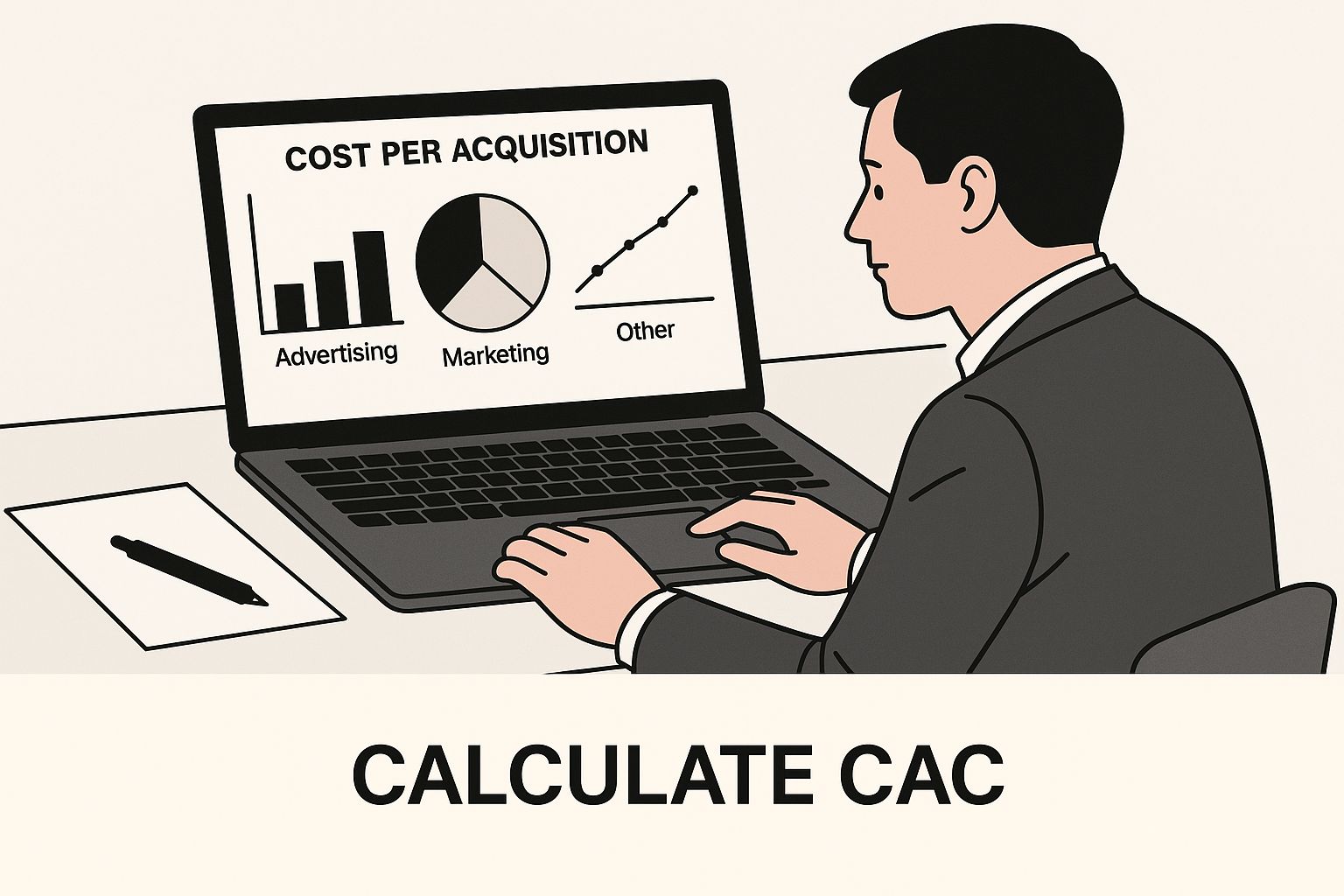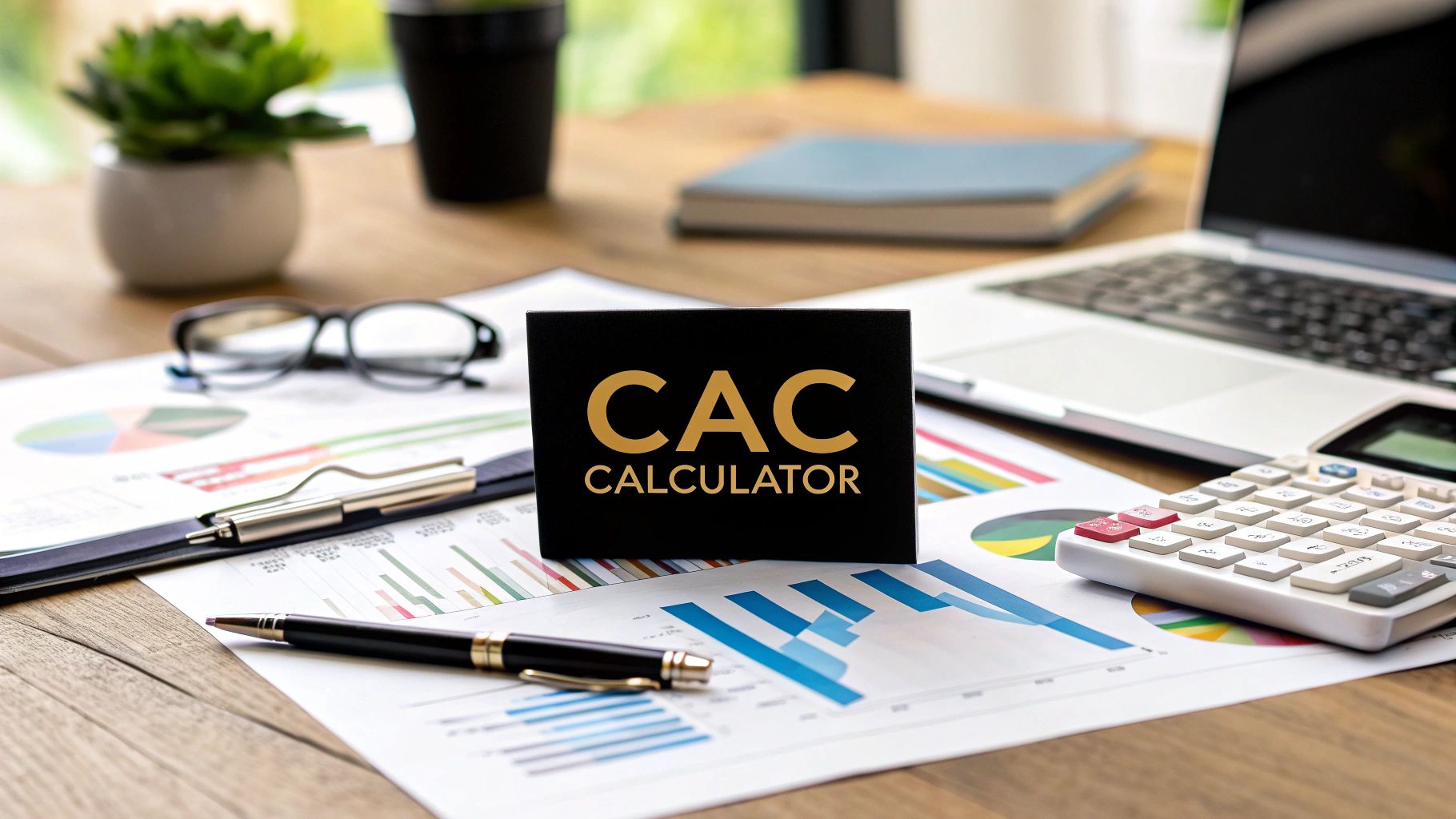Why Your CAC Numbers Are Make-or-Break for Business Success

Customer Acquisition Cost (CAC) is more than just a metric; it's a vital indicator of your business's health. It represents the investment needed to acquire each new customer, directly impacting the sustainability of your marketing strategies. A manageable CAC fuels growth, while an excessive one can deplete resources and jeopardize your business. Understanding and optimizing your CAC is paramount for long-term prosperity.
Understanding the Importance of CAC
CAC serves as a key performance indicator (KPI) for your marketing efforts. A low CAC generally indicates a positive return on your marketing investment. Conversely, a high CAC might signal the need to re-evaluate and adjust your strategies. Tracking CAC across different marketing channels can provide valuable insights into their individual profitability, enabling you to allocate your budget strategically. This optimization leads to improved return on investment and sustainable growth.
Furthermore, CAC plays a critical role in attracting investors. It provides a crucial lens through which they assess the sustainability and scalability of your business model. A well-managed CAC instills confidence and demonstrates a clear understanding of market dynamics.
The Real Impact of CAC on Business Decisions
Understanding your CAC empowers you to make data-driven decisions across various business functions. You can allocate resources more effectively, pinpoint profitable customer segments, and refine your sales funnel. This transforms CAC from a simple metric into a strategic tool.
For example, calculating CAC involves dividing your total sales and marketing costs by the number of new customers acquired within a specific period. If a company spends $40,000 on marketing and sales and acquires 160 new customers, their CAC is $250 per customer. This metric enables comparisons across various channels, informing optimization efforts. To understand industry benchmarks, explore resources like UserMaven for insights on average CAC across different industries.
Recognizing Warning Signs of High CAC
Several factors can contribute to a high CAC, and recognizing these red flags is essential for corrective action. These might include targeting the wrong audience, running ineffective marketing campaigns, or experiencing a lengthy sales cycle. For further guidance on lowering your CAC, consider resources like RefGrow.
Identifying the root causes of a high CAC is the first step towards implementing effective reduction strategies. This might involve refining your target audience, optimizing your messaging, or streamlining your sales process.
Ignoring a high CAC can have detrimental consequences, hindering growth and impacting profitability. A high CAC signifies that you are overspending to acquire customers, reducing your profit margins and potentially leading to financial instability.
Calculate CAC Like a Pro: No More Guesswork
Knowing your Customer Acquisition Cost (CAC) is essential for business success. It's not enough to simply calculate a number; you need to understand the nuances behind it. This requires a thorough examination of all contributing factors, both obvious and hidden.
Unpacking the CAC Calculation: Essential Components
The basic CAC calculation is straightforward: Total Sales and Marketing Costs / Number of New Customers Acquired. However, accurately defining "sales and marketing costs" is critical. While advertising and marketing salaries are easily identified, other expenses are often overlooked.
- Overhead: Allocate a portion of your general overhead expenses, such as office space, utilities, and administrative support, to your marketing efforts.
- Software & Tools: Include the costs of essential marketing resources like marketing automation platforms, CRM systems, and analytics software.
- Content Creation: Factor in the expenses associated with developing valuable content, including blog posts, videos, and infographics.
- Agency Fees: If you utilize external agencies, their fees contribute directly to your CAC.
Understanding these components provides a complete picture of your CAC. You can learn more about calculating customer acquisition cost from resources like this article on how to calculate customer acquisition cost.
Navigating Tricky CAC Scenarios
Real-world businesses face complexities that impact CAC calculation:
- Multi-Touch Attribution: Customers rarely convert through a single interaction. Accurately attributing costs across multiple touchpoints is essential.
- Shared Team Costs: Allocate costs appropriately when teams contribute to both sales and marketing functions.
- Seasonal Variations: Account for seasonal fluctuations in spending and acquisition rates to normalize your CAC data.
Addressing these challenges requires careful data collection and analysis.
Data Collection Best Practices for Accurate CAC
Accurate CAC relies on diligent data collection.
- Track All Expenses: Maintain comprehensive records of every sales and marketing expenditure.
- Use a Consistent Timeframe: Choose a regular reporting period (monthly, quarterly, or annually) and stick to it.
- Segment Your Data: Calculate CAC for individual channels, campaigns, and customer segments for targeted insights.
By segmenting data, you can identify the effectiveness of different marketing channels and refine your strategies accordingly. This allows for optimized spending and effective resource allocation.
Calculating CAC is not complex, but it requires careful consideration of the relevant time period and associated costs. Tools like Coefficient’s CAC calculator can help streamline this process. You can discover more insights about CAC calculation using resources like this. Regularly tracking and analyzing your CAC empowers data-driven decisions, improves marketing ROI, and contributes to overall growth.
Common CAC Calculation Mistakes to Avoid
Inaccurate CAC calculations can lead to poor decisions. Common errors include:
- Ignoring Overhead Costs: Failing to account for overhead results in an artificially low CAC.
- Inconsistent Attribution: Using different attribution models across channels creates unreliable comparisons.
- Not Segmenting Data: Relying solely on an overall CAC number obscures valuable insights into specific channels and campaigns.
Avoiding these pitfalls ensures you have a clear, actionable view of your customer acquisition efforts, enabling better decision-making.
Calculator Tools That Actually Make CAC Analysis Simple

The infographic above shows a professional reviewing CAC data visualized on charts. This highlights how important using a customer acquisition cost (CAC) calculator is. The image emphasizes the shift from manual spreadsheet calculations to streamlined, data-driven insights. It also underscores how vital CAC analysis is for making informed business decisions.
Say goodbye to the days of wrestling with complex spreadsheets. Modern CAC calculator tools simplify the process, providing valuable business insights. These tools range from basic calculators to full-fledged analytics platforms. This means businesses can choose a tool that fits their specific needs and budget.
Key Features of Effective CAC Calculators
Effective CAC calculators go beyond basic number crunching. They offer features that allow for deeper analysis.
Automated Data Collection: Integrate with your current marketing and sales platforms to automatically pull in the data you need. This removes manual data entry, which saves time and reduces errors.
Multi-Channel Attribution: Correctly attribute costs across your different marketing channels. This helps you understand each channel’s contribution to customer acquisition. For example, track spending and conversions across social media, paid advertising, and email marketing.
Real-Time Tracking: Keep an eye on your CAC in real time. This helps you to spot trends and make proactive changes to your strategies. You can quickly address rising costs and optimize campaigns for better performance.
Scenario Planning: Model different scenarios to understand the potential effects of changes in your marketing spend or customer acquisition strategies. This allows for more data-driven decision-making and minimizes risks.
These features help you understand your CAC and what it means for your business. Using CAC calculators has become increasingly important for businesses to analyze how efficiently they acquire customers. These tools let companies easily input their sales and marketing expenses and the number of new customers acquired to get a clear picture of their CAC.
For example, Ajelix offers a free CAC calculator. This tool helps businesses quickly determine their customer acquisition costs without complex manual calculations.
To help you choose the right tool, we’ve compiled a comparison of popular CAC calculators. This table summarizes key features, pricing, and what each tool is best suited for.
The following table compares popular CAC calculator tools, highlighting key features, pricing, and integration options to help you choose the right solution for your business.
| Tool Name | Key Features | Pricing | Best For | Integration Options |
|---|---|---|---|---|
| Ajelix CAC Calculator | Simple input, quick calculation | Free | Startups, small businesses | Limited |
| HubSpot | Marketing analytics dashboard, CAC reporting | Varies based on plan | Growing businesses, marketing teams | HubSpot CRM, other marketing platforms |
| Salesforce | Sales and marketing cloud, CAC tracking | Varies based on plan | Enterprise businesses, sales teams | Salesforce ecosystem |
This comparison table offers a quick overview of some popular CAC calculator tools. As you can see, options range from free basic calculators to more robust solutions integrated into larger platforms. Consider your business needs and budget when making a selection.
Choosing the Right CAC Calculator
The right CAC calculator depends on your business needs. Basic calculators work well for startups and small businesses with simpler acquisition models. As your business grows and your marketing becomes more complex, you might consider a comprehensive analytics platform. These platforms can handle more sophisticated scenarios, like subscription models and enterprise-level operations. This ensures your CAC analysis stays relevant and insightful as your business changes.
Integrating CAC Calculators with Your Existing Systems
Integrating with your current marketing and sales systems is vital for accurate and efficient CAC analysis. This integration automates data collection, eliminating manual data entry. Real-time tracking gives you up-to-the-minute insights into your CAC, allowing for proactive adjustments and optimizations to your marketing strategies. Choosing a calculator that works well with your current setup is a key step in getting the most out of your CAC data.
Channel-by-Channel CAC Optimization That Actually Works
Optimizing your Customer Acquisition Cost (CAC) is crucial for sustainable growth. Understanding how each channel contributes is essential for strategic resource allocation and maximizing ROI. Don't just look at the overall CAC; delve deeper.
Identifying Your Most and Least Profitable Channels
The first step is to break down your CAC by channel. Calculate the CAC for each marketing avenue, including paid advertising, social media, email marketing, and content marketing.
This data reveals your star performers (low-cost customer acquisition) and underperformers (high cost, low results). Think of it like managing investments; focus on what yields the highest returns.
Practical Techniques for CAC Reduction
Once you've identified underperforming channels, it's time to optimize. Here are some key strategies:
Audience Segmentation: Target the right audience on each channel. LinkedIn might be best for B2B, while Instagram might suit a younger demographic.
Message Optimization: Tailor messaging to resonate with each channel's audience. A/B test headlines, calls to action, and visuals.
Funnel Improvements: Analyze conversion rates at each sales funnel stage for every channel. Identify and address bottlenecks to improve lead flow.
For example, a low landing page conversion rate for a specific channel might require a redesign or a clearer offer. Tools like the window replacement cost calculator from Gladiator Windows and Doors, while not directly related to CAC, illustrate the value of readily available tools for financial analysis.
Balancing Short-Term and Long-Term Goals
Short-term CAC gains are important, but don't sacrifice long-term brand building. Slashing your social media budget might lower your CAC initially, but could harm brand visibility and organic reach over time. Sustainable growth requires balancing both. Reduce costs today while building brand equity for the future.
The Power of Data-Driven Decisions
Analyzing CAC by channel empowers data-driven budget allocation decisions, significantly impacting overall acquisition costs. Research indicates businesses using this approach can reduce costs by 23-41% while improving customer quality. The most successful companies reallocate budget monthly based on channel performance. Learn more here.
Use your CAC insights to continuously refine your marketing strategy and drive sustainable growth. Regularly review and adjust your channel-specific CAC to ensure you're investing in the most effective strategies. This ongoing optimization is crucial for staying competitive and maximizing marketing ROI.
Industry CAC Benchmarks That Actually Matter

Comparing your Customer Acquisition Cost (CAC) to generic benchmarks can be misleading. True insight comes from understanding the standards relevant to your specific business. Customer acquisition costs vary significantly across industries, business models, and growth stages. This means your target CAC should align with realistic expectations.
Understanding Industry Variations
Different industries face unique challenges and opportunities when acquiring customers. For example, the SaaS industry often benefits from scalable business models and shorter sales cycles, potentially leading to a lower CAC.
However, industries with complex sales processes and longer sales cycles, such as enterprise software or commercial insurance, often see higher CACs. This is due to the increased time and resources required to convert a customer.
The Impact of Business Models and Growth Stages
Beyond industry differences, your business model and growth stage also impact CAC. A subscription-based business will have different CAC dynamics compared to a one-time purchase model.
Similarly, startups in their early stages often invest heavily in customer acquisition to gain initial traction, resulting in a potentially higher CAC initially. As these businesses mature and scale, their CAC typically decreases.
Interpreting Benchmark Data Correctly
When using industry benchmarks, it's crucial to compare your CAC to businesses with similar characteristics. Ensure you're comparing your CAC to businesses with similar business models, growth stages, and target audiences.
For example, comparing the CAC of a bootstrapped startup to a venture-backed competitor can lead to inaccurate conclusions. For a deeper dive into SaaS-specific CAC, check out this resource: How to Master SaaS Customer Acquisition Cost.
Setting Realistic CAC Targets
Setting achievable CAC targets requires a deep understanding of your market and business goals. Your target CAC should align with your pricing strategy and projected customer lifetime value (LTV).
Aim for a healthy LTV:CAC ratio, typically 3:1 or higher. This indicates that the value generated by each customer significantly outweighs the cost of acquiring them. A well-defined target CAC informs budget allocation and strategic decisions.
To help you benchmark your CAC, let's look at some industry averages.
The following table provides an overview of average customer acquisition costs across different industries and business models. This data, sourced from FirstPageSage 2023, is intended to help you benchmark your performance and identify potential optimization opportunities.
Industry CAC Benchmarks and Standards
| Industry | Average CAC | CAC Range | Key Factors | Optimization Opportunities |
|---|---|---|---|---|
| B2B SaaS | $300 | $200 - $400 | Scalable models, digital marketing | Content marketing, SEO, Referral programs |
| Real Estate | $900 | $600 - $1200 | Competitive landscape, long sales cycles | Targeted advertising, Local partnerships |
| Higher Education | $1400 | $800 - $2000 | Niche audiences, extensive outreach | Digital campaigns, Community engagement |
| IT & Managed Services | $550 | $300 - $800 | Competitive landscape, technical sales | Content marketing, Lead nurturing |
Remember these are averages. A business with a high average order value might justify a higher CAC. Conversely, a business operating on thin margins needs to keep its CAC tightly controlled. Continuously analyzing your CAC, alongside other key metrics, will guide your strategic decisions and ensure sustainable growth.
Key Takeaways for CAC Mastery
Mastering your Customer Acquisition Cost (CAC) isn't a one-time fix, but an ongoing process. It requires continuous tracking, analysis, and optimization. This section offers a practical roadmap for implementing a CAC-focused strategy to drive real business results.
Building a CAC-Driven Culture
Begin by cultivating a data-driven decision-making culture around customer acquisition. This empowers your team to understand CAC and contribute to reducing it. Think of it as a collaborative effort, where everyone works towards a shared goal. Regularly sharing CAC data and involving your team in optimization discussions can spark creative solutions and increase overall engagement.
Implementing Effective Tracking Processes
Robust CAC monitoring is crucial for accurate analysis. This involves establishing clear data governance policies, setting reporting schedules, and defining team accountabilities. Your CAC tracking system acts as your business's central nervous system, providing essential information for informed decisions.
- Data Governance: Create clear guidelines for data collection, storage, and access to ensure data integrity and consistency.
- Reporting Cadence: Set a regular reporting schedule (weekly, monthly, quarterly) to monitor CAC trends and identify potential problems early.
- Team Accountability: Assign clear responsibilities for data collection and analysis to ensure accuracy and ownership.
These processes need to be scalable to adapt as your business grows. Your CAC tracking capabilities should expand alongside your business.
Actionable Steps for CAC Optimization
True CAC mastery involves actionable steps with measurable results.
- Step 1: Calculate Your Current CAC: Determine your current CAC using this formula: Total Sales and Marketing Costs / Number of New Customers Acquired. Include all relevant costs, like overhead, software, and content creation.
- Step 2: Benchmark Against Your Industry: Compare your CAC to industry averages to gauge your performance and pinpoint areas for improvement. Industry standards vary, so select relevant benchmarks.
- Step 3: Identify Top-Performing Channels: Figure out which acquisition channels deliver the lowest CAC and the highest return on investment. You might find this resource helpful: How to master your Customer Acquisition Strategy.
- Step 4: Optimize Underperforming Channels: Focus on improving channels with high CAC and low conversion rates. This could involve refining targeting, messaging, or the sales funnel.
- Step 5: Implement and Monitor: Put your optimization strategies into practice and continuously monitor their effect on your CAC. Be flexible and adjust your approach based on the results.
Troubleshooting and Continuous Improvement
Even the best strategies can encounter challenges. Be ready to troubleshoot and adapt. For example, if a channel's CAC unexpectedly rises, investigate the cause and implement corrective measures.
- Analyze data trends: Regularly review CAC data for unusual spikes or dips, which can signal underlying problems.
- Gather team feedback: Involve your sales and marketing teams in troubleshooting. They often offer valuable channel-specific insights.
- A/B test solutions: Experiment with different strategies to discover the most effective ways to lower your CAC.
By embracing continuous improvement, you refine your CAC strategies and maximize ROI over time. Consistent analysis and optimization of your customer acquisition process are crucial for long-term success.
Ready to transform your affiliate program and reduce your CAC? Refgrow, the fully embeddable affiliate software for SaaS, empowers you to turn existing users into a powerful growth engine. Learn more about how Refgrow can help you scale your business.

